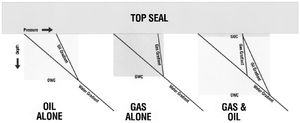Seal capacity and two-phase hydrocarbon columns
| It has been suggested that this article be merged with [[::Seal capacity|Seal capacity]]. (Discuss) |
| Exploring for Oil and Gas Traps | |

| |
| Series | Treatise in Petroleum Geology |
|---|---|
| Part | Predicting the occurrence of oil and gas traps |
| Chapter | Evaluating top and fault seal |
| Author | Grant M. Skerlec |
| Link | Web page |
| Store | AAPG Store |
Two phases are better than one
Seal capacity depends on both the hydrocarbon phase and the physical character of the top seal. Since displacement pressure is a function of the seal and the coefficient of interfacial tension of the hydrocarbon phase beneath the seal, it is possible to trap a thicker two-phase hydrocarbon column than oil alone or gas alone.[1] The gas in contact with the base of the seal determines the displacement pressure (Pd) of the seal. The buoyant effect of the oil column, however, is less than that of a pure gas column, and a greater total hydrocarbon column can be trapped.
Single phase vs. two phase

Figure 1 compares the seal capacity of a top seal with a single-phase oil accumulation, a single-phase gas accumulation, and a two-phase accumulation with both an oil leg and a gas cap. The largest hydrocarbon column is sealed by the two-phase accumulation. This best applies to traps with a geometry such that only the gas column is in contact with the seal. It also applies to fault traps.
See also
- Seal capacity
- Seal capacity of different rock types
- Seal capacity variation with depth and hydrocarbon phase
- Seal thickness
- Fault-dependent leak points, continuity, and charge